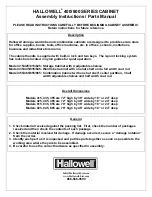
Installing the NAS
24
Fujitsu
RAID 5 Disk Volume
The data are striped across all the hard
drives in a RAID 5 array. The parity
information is distributed and stored across
each hard drive. If a member hard drive
fails, the array enters degraded mode. After
installing a new hard drive to replace the
failed one, the data can be rebuilt from other
member drives that contain the parity
information.
To create a RAID 5 disk volume, a minimum
of 3 hard drives are required. The storage
capacity of a RAID 5 array is equal to (N-1)
(size of smallest hard drive). N is the
number of hard drives in the array.
RAID 6 Disk Volume
The data are striped across all the hard
drives in a RAID 6 array. RAID 6 differs from
RAID 5 that a second set of parity
information is stored across the member
drives in the array. It tolerates failure of two
hard drives.
To create a RAID 6 disk volume, a minimum
of 4 hard drives are required. The storage
capacity of a RAID 6 array is equal to (N-2)
(size of smallest hard drive). N is the
number of hard drives in the array.
RAID 10 Disk Volume
RAID 10 combines four or more disks in a
way that protects data against loss of non-
adjacent disks. It provides security by
mirroring all data on a secondary set of
disks while using striping across each set of
disks to speed up data transfers.
RAID 10 requires an even number of hard
drives (minimum 4 hard drives). The storage
capacity of RAID 10 disk volume is equal to
(size of the smallest capacity disk in the
array) N/2. N is the number of hard drives in
the volume.
RAID 10 tolerates failure of only two disks
from two different sets of disks.
►
Select the desired
File System
.
►
Click
on
Next
and then on
Start Installation
.
















































